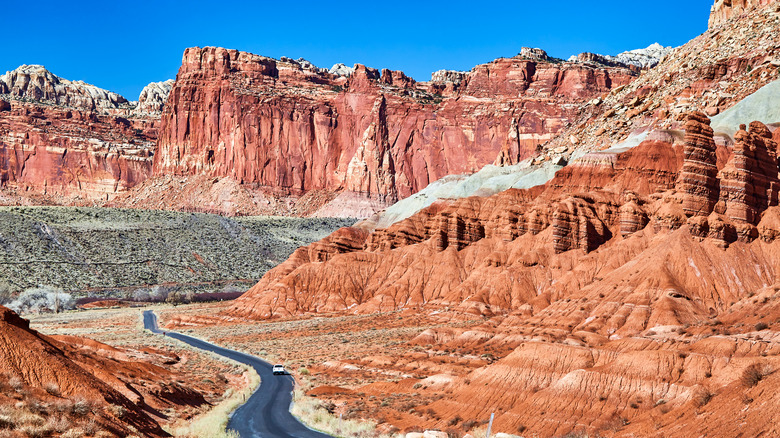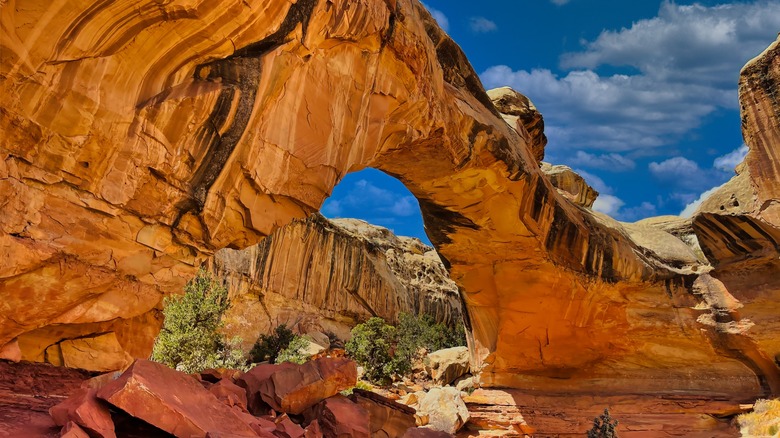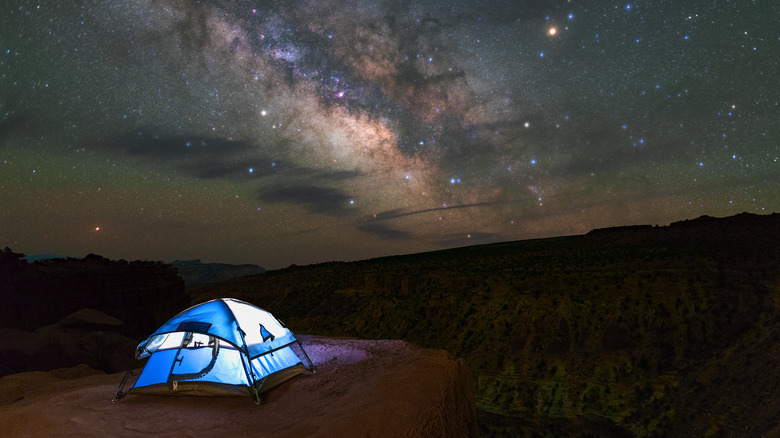One Of Utah's Most Impressive Destinations Is This Picturesque Red Rock National Park
When you think about Utah's national parks, Zion National Park, with its iconic (and at times dangerous) Angels Landing trail, or Arches National Park, with more natural sandstone arches than anywhere else on the planet, might top the list. But don't forget about Capitol Reef National Park in south-central Utah with incredible natural beauty featuring amazing red rock formations, canyons, and cliffs. It first became a national monument in 1937, and it was then elevated to a national park in 1971, offering fantastic hiking, camping, stargazing, and more.
This remote park is located between Canyonlands National Park and Bryce Canyon National Park, making it an easy stop if you're planning an epic road trip through Utah to visit all five of its national parks. The nearest town is the smaller Torrey, with fewer than 300 people and less than 10 miles from the park's west entrance. The closest city is Moab, Utah, which is about a 2-hour drive from the park's east side.
The desert landscape is about as far from an ocean reef as you can get, so the name might seem a bit odd at first. The reef part of the name comes from the 87-mile-long ridge called the Waterpocket Fold; it runs north and south, and according to the National Park Service, prospectors from back in the day called it a reef. The Capitol part of the name comes from how the white sandstone domes in the region look like the U.S. Capitol dome.
Hiking at Capitol Reef National Park offers amazing views
Capitol Reef National Park is divided into three main sections: The central Fruita Historic District (which is the most visited), Cathedral Valley District to the north, and Waterpocket District to the south. If you're an intrepid (and prepared traveler) who wants a more rugged experience away from crowds, go to the north and south districts.
The hikes at Capitol Reef can take you through slot canyons, along cliff edges and river banks, and beneath stone arches. One popular, easy hike is the Capitol Reef Petroglyph Trail in the Fruita Historic District, as this wheelchair-accessible trail is less than half-mile along two boardwalks, and along the way, you can see petroglyphs made by indigenous people over 1,000 years ago. The 3.6-mile Cassidy Arch trail via Grand Wash is a more strenuous option in the Fruita Historic District, which will take you to a dramatic stone arch, one of the park's most popular photo spots. Famous outlaw Butch Cassidy gave the formation its name, and its a stunning arch set amidst multi-colored red canyon walls. Another well-known arch hike is the 2-mile out and back to Hickman Bridge.
Hiking in both the Cathedral and Waterpocket Districts is a much more adventurous experience as the trails are not maintained. They're the places to go if you want to go backpacking or to test your route-finding skills, and particularly in the Cathedral District, you'll need to have a high-clearance vehicle to get around.
Take in Capitol Reef's centuries-old fruit trees, camping, and stargazing
While much of Capitol Reef National Park is desert, you can find nearly 2,000 fruit trees near the visitor center. They were originally planted by Mormon settlers in the 1880s along the Fremont River, and they give this part of the park its name. Visitors are allowed to pick and take the apples, peaches, pears, and more in season.
Bring camping gear for a vacation adventure at Capitol Reef, as the Fruita Campground near the river and the park's orchards has 71 sites with water and toilets. It's reservation-only from March 1 to October 31, and it can fill up quickly. There are also some primitive backcountry camping options in the park, and Bureau of Land Management (BLM) land near the national park can be used for camping. It's well worth spending the night here; you'll get to see the full splendor of the night sky with the Milky Way frequently in full view — the skies are so spectacular here that in 2015, it was recognized as an International Dark Sky Park.
When you're planning your visit, keep in mind that it can get hot during the summer — upwards of 100 degrees Fahrenheit during the day — so if you're visiting at this time, plan your outdoor activities for the early morning and evening. Winters generally mean far fewer crowds, but you have to be prepared for temps below freezing at night and only into the 40s during the day. The ideal weather windows to visit Capitol Reef are in spring and fall.


